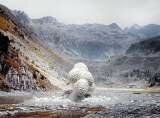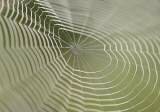|
|
||
Fecha: 29 de septiembre del 2013
Astronomers often use "false-color" images to better understand deep space phenomena like supernova remnants or nebulae. But false color imagery is also used a bit closer to home.
As evidenced by stunning new photos of the surface of Mars taken by the High Resolution Imaging Science Experiment (HiRISE) camera aboard the Mars Reconnaissance Orbiter.
When HiRISE captured this view, the Mars Reconnaissance Orbiter was rolled for an eastward-looking angle rather than straight downward. The afternoon sun illuminated the scene from the western sky, so the lighting was nearly behind the camera. Specifically, the angle from sun to orbiter to rover was just 5.47 degrees.
HiRISE takes pictures in three color bands: 400 to 600 nanometers (blue-green), 550 to 850 nm (red) and 800 to 1,000 nm (near infrared). Since the human eye sees wavelengths from about 390 to 700 nm, HiRISE cross-maps the longer bands to the visible spectrum, creating a false-color image that helps viewers see features more clearly.
Curiosity has now moved on, and is now heading towards the large mound in Gale Crater (with long drives!) officially named Aeolis Mons.
HiRISE represents a collaboration between NASA’s Jet Propulsion Laboratory and the University of Arizona. It is one of several instruments on the Mars Reconnaissance Orbiter, which was launched in 2005.







As evidenced by stunning new photos of the surface of Mars taken by the High Resolution Imaging Science Experiment (HiRISE) camera aboard the Mars Reconnaissance Orbiter.
When HiRISE captured this view, the Mars Reconnaissance Orbiter was rolled for an eastward-looking angle rather than straight downward. The afternoon sun illuminated the scene from the western sky, so the lighting was nearly behind the camera. Specifically, the angle from sun to orbiter to rover was just 5.47 degrees.
HiRISE takes pictures in three color bands: 400 to 600 nanometers (blue-green), 550 to 850 nm (red) and 800 to 1,000 nm (near infrared). Since the human eye sees wavelengths from about 390 to 700 nm, HiRISE cross-maps the longer bands to the visible spectrum, creating a false-color image that helps viewers see features more clearly.
Curiosity has now moved on, and is now heading towards the large mound in Gale Crater (with long drives!) officially named Aeolis Mons.
HiRISE represents a collaboration between NASA’s Jet Propulsion Laboratory and the University of Arizona. It is one of several instruments on the Mars Reconnaissance Orbiter, which was launched in 2005.


Anuncios Google














